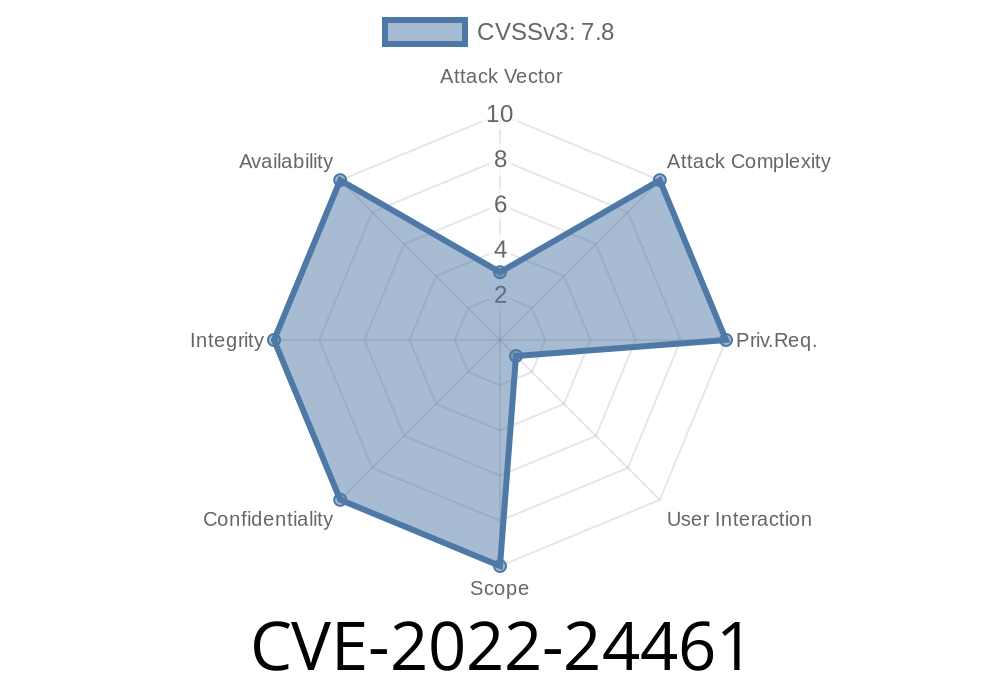The CVE-2022-24461 identifies a critical security vulnerability in Microsoft Office Visio that may lead to remote code execution. This vulnerability is unique from CVE-2022-24509 and CVE-2022-24510. This post will discuss the details of CVE-2022-24461, including its origin, potential exploits, and mitigation strategies.
Vulnerability details
The vulnerability in the Microsoft Office Visio application is due to improper handling of user input, especially when parsing Visio documents. Specifically, the vulnerability can be triggered by opening a malicious Visio file, allowing an attacker to run arbitrary code on the victim's system. This type of exploit is classified as a Remote Code Execution (RCE) vulnerability.
According to the original advisory by Microsoft (available here), this vulnerability has been assigned a severity rating of 'Important' with a CVSS base score of 7.8. The vulnerability is present in Microsoft Office Visio 201, 2013, and 2016, impacting both 32-bit and 64-bit versions of the applications.
The following is an example snippet illustrating a potential exploit via a malicious Visio file
<visio:DocumentProperties>
<visio:Filename><![CDATA[JavaScript_code]]></visio:Filename>
...
<o:OLEObject Type="Embed" ProgID="Visio.Drawing" ...
... DrawAspect="Content" ObjectID="1234"/>
</visio:DocumentProperties>
<visio:Shape o:id="_x000_s1025" ObjectType="OLE object">
<v:TextBox><![CDATA[JavaScript_code]]></v:TextBox>
...
<visio:Event Enabled="True" ... Event="NoShow"/>
</visio:Shape>
Exploit details
An attacker can exploit this vulnerability by sending an email containing a malicious Visio file or making it available for download. Once the victim opens this file, the embedded malicious code will be executed. This RCE allows the attacker to perform various malicious actions, such as stealing sensitive information or placing additional malware on the victim's system.
Mitigations
Microsoft has released security patches for the affected Microsoft Office Visio versions to address the CVE-2022-24461 vulnerability. Users should promptly apply the provided updates to mitigate this security risk. The official links to download these updates are as follows:
- Office 201: Download update KB5002212
- Office 2013: Download update KB5002221
- Office 2016: Download update KB5002226
Regularly backup all your important data to minimize the impact of successful attacks.
3. Ensure the operating system and installed applications are always up-to-date with the latest security patches.
Conclusion
The CVE-2022-24461 vulnerability in Microsoft Office Visio poses a significant risk of Remote Code Execution. This vulnerability was addressed in Microsoft's recent security updates, and users should download and install these updates to secure their systems against potential exploits.
For more information on CVE-2022-24461, refer to the official security advisory by Microsoft here.
However, remember that CVE-2022-24461 is unique from CVE-2022-24509 and CVE-2022-24510. For information on these separate vulnerabilities, please consult the relevant updates and advisories provided by Microsoft.
Timeline
Published on: 03/09/2022 17:15:00 UTC
Last modified on: 03/14/2022 18:52:00 UTC
